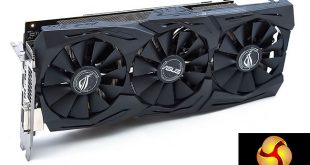
Nvidia's GTX 1060 is now available to buy and while the reference design (Founders Edition) is an interesting choice, it's the customised variants from Nvidia partners that should offer the best cooling, performance and feature set. The ASUS GTX 1060 STRIX is the first of the custom GTX 1060s to be tested by KitGuru so let's see what it has to offer.
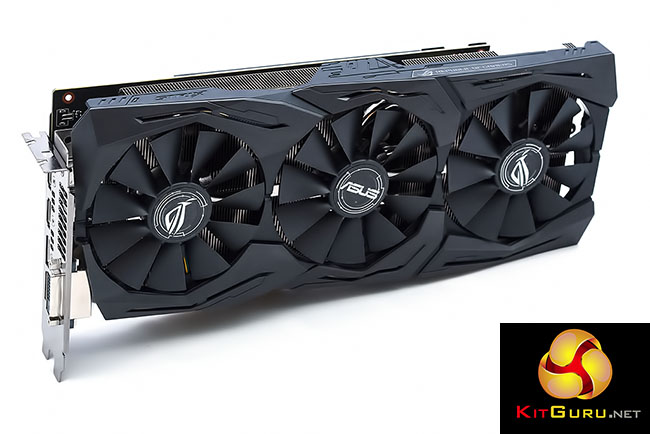
At a quick first glance the ASUS GTX 1060 STRIX is almost identical to the ASUS GTX 1070 STRIX and that's for a valid reason. ASUS has reused the same board design which means an excellent triple-fan cooler, full backplate and Aura RGB functionality. The GTX 1060 STRIX arrives in two different SKUs, an OC variant and a standard one with the only observable differences between the two being frequencies and pricing.
In for review we have the OC model which has a boost clock of 1845MHz and slight memory overclock of 8208MHz (effective). Given the non-existent differences between this and the standard variant it seems the price increase of $/£20 is a bit steep and prospective buyers comfortable with overclocking should consider the cheaper option and overclock it themselves.
Pricing will likely be a contentious issue for the GTX 1060s as it's more of a value-oriented model than the GTX 1070. Nvidia says GTX 1060 pricing starts from £239.99 which is technically true, a handful of models are available around this price point, but most prestigious manufacturers, including ASUS, seem to be using the Founders Edition (£275/$300) as the baseline and pricing suitably above that level.
While it's easy to be critical of that pricing, ASUS does a lot to justify the premium including – full RGB functionality, uprated-quality components, automated production, dual HDMI ports for VR and onboard GPU-controlled fan headers.
In light of the recent clock speed controversy that embroiled a number of graphics card vendors ASUS has been fully transparent about what the out-of-the-box frequency will be for customers. Those frequencies are the ones we've tabulated below and as such we tested the ASUS GTX 1060 STRIX in this configuration, users will be able to install ASUS GPU Tweak II and enable the faster OC mode with one simple click.
| GPU | Nvidia GTX 1060 Founders Edition |
ASUS GTX 1060 STRIX |
ASUS GTX 1060 STRIX OC |
| GPU Cores | 1280 | 1280 | 1280 |
| Base Clock | 1506 MHz | 1506 MHz | 1620MHz |
| GPU Boost Clock | 1708 MHz | 1708 MHz | 1845MHz |
| Total Video memory | 6144 MB | 6144 MB | 6144 MB |
| Memory Clock | 4006 MHz | 8008 MHz | 8208 MHz |
| Memory Bandwidth | 192 GB/s | 192 GB/s | 197 GB/s |
| Bus Width | 192-bit | 192-bit | 192-bit |
| Price (£/$) | £275/$300 | £300/$310 | £320/$330 |
The ASUS GTX 1060 STRIX OC's key features are prominently displayed on the packaging including its RGB and VR credentials.
The accessory bundle is almost becoming irrelevant these days since drivers are best downloaded from the internet and power adapters shouldn't be required if the system power supply is up to scratch. The only items of note are some ROG-branded cable ties but there is a driver CD and speed setup guide if required, as well as a World of Warships code.
The ASUS GTX 1060 STRIX is a surprisingly large product for its 120W TDP. This could divide the crowd – some may say it should be a more compact and lean package, while others will welcome its overkill cooling solution as it should result in low temperatures and noise output. Although, ASUS likely has an ITX variant in the works anyway if past trends are anything to go by.
The fitted backplate finishes off the polished design of the product, ASUS has done a solid job of making this card look the part.
Power is taken in through a single 8pin, that's an alteration from the standard 6pin on the Founders Edition card.
At the end of the heatsink you can see the four nickel plated copper heat pipes with the fifth not visible as it points towards the rear I/O.
Despite the impressive cooling implementation ASUS strictly adheres to a dual-slot form factor these days which should aid compatibility with other PCIe devices, sound cards, network cards, even chunky CPU coolers.
This has little implication for multi-GPU compatibility though since the GTX 1060 doesn't support SLI.
The rear I/O is similar to the stock Nvidia configuration with the exception that one of the Display Port 1.4 ports has been swapped for another HDMI 2.0 to help with VR devices like the HTC Vive.
The sum of the rear I/O is two HDMI 2.0, one DVI-D dual-link and two DisplayPort 1.4.
Our newest GPU test system has been built with the intention of benchmarking low to mid-range graphics cards, we have a separate test system which benchmarks higher-end graphics cards such as the RX 480, GTX 1070 and GTX 1080. To reflect the performance of GPUs being tested the scope of testing has been reduced to 1080p and 1440p, since 4K is largely irrelevant for GPUs of this price point.
General Test System Notes
- AMD Graphics cards were benchmarked with the AMD Crimson Display Driver 16.6.1, though the RX 480 was tested on 16.7.2 to rectify power issues with the PCI Express slot
- Nvidia Graphics cards with the Nvidia Forceware 368.39 driver except the newer Nvidia GTX 1060 which was tested using its 368.64 release driver
- To tune the test system appropriately for acoustic measurements the case was outfitted with ultra quiet Noctua 800RPM fans and the Corsair H100i set to a fixed fan speed of 700RPM to further reduce the base noise level.
- The CPU was left to default Intel Turbo behaviour, disabling motherboard manufacturer enhancements such as all-core Turbo to minimise heat output inside the case and non-GPU related power consumption.
- Each benchmark or game is run 3 times at each resolution with an average result of the three runs taken as the final result for the graphs. Where benchmark screenshots are shown note these may not match the graphed figure since an average of three is taken.
Test System Components
- Case: Corsair 400Q (two stock case fans replaced with Noctua 800 RPM 120mm rear exhaust and 140mm front intake fans)
- Processor: Intel Core i7-6700K (Stock Intel Turbo behaviour).
- Memory: 32GB (4 x 8GB) G.Skill Trident Z DDR4 running at JEDEC 2800MHz.
- Graphics Card: Variable.
- System Drive: Mushkin Chronos 120GB.
- Games Drive: Samsung 850 EVO 512GB SSD
- CPU Cooler: Corsair H100i w/ Noctua NTH1 (fan speed limited to 700 RPM on Corsair H100i).
- Power Supply: Seasonic Platinum 760W.
- Operating System: Windows 10 Pro 64-bit.
Comparison Graphics Cards List
- EVGA GTX 750 Ti 2GB Superclocked (1176MHz core, 1255MHz boost, 5400MHz memory )
- MSI R7 370 2GB Gaming (980MHz core, 1030MHz boost, 5600MHz memory)
- MSI R9 380 4GB Gaming (980MHz core, 5700MHz memory)
- MSI R9 390 8GB Gaming (1040MHz core, 6000MHz memory)
- PNY GTX 950 2GB XLR8 OC Gaming (1152MHz core, 1342MHz boost, 7200MHz memory)
- PNY GTX 960 4GB XLR8 OC Gaming (1203MHz core, 1266MHz boost, 7200MHz memory)
- Sapphire R9 380X 4GB Nitro OC (1040MHz core, 6000MHz memory)
- XFX R7 360 2GB Core Edition (1050MHz core, 6000MHz memory)
- Zotac GTX 970 4GB (1076MHz core, 1216MHz boost, 7010MHz memory)
- ASUS GTX 950-2G (1026MHz core, 1190MHz boost, 6612MHz memory)
- AMD RX 480 8GB (1266MHz core, 8000MHz memory)
- AMD RX 480 4GB (8GB card with 4GB vBIOS, 1266MHz core, 7000MHz memory)
- Nvidia GTX 1060 6GB Founders Edition (1506MHz core, 1708MHz boost, 8008MHz memory)
- Nvidia GTX 1070 8GB Founders Edition (1506MHz core, 1683MHz boost, 8008MHz memory)
- ASUS GTX 1060 6GB STRIX OC (1620MHz core, 1848MHz boost, 8208MHz memory)
Software and Games List
- 3DMark
- Ashes of the Singularity
- Furmark
- GPU-Z
- Grand Theft Auto V
- Metro Last Light Redux
- Middle-earth: Shadow of Mordor
- MSI Afterburner
- Rise of the Tomb Raider
- Steam
- Unigine Valley
As a product geared towards VR the Steam VR score of the ASUS GTX 1060 STRIX is important to consider. The Founders Edition card scored 8.2, so 8.9 is a nice improvement and a bit more overclocking should see scores into the low 9s.
Overall, the GTX 1060 is a VR ready GPU and the ASUS STRIX treatment makes it that little bit faster while the premium cooling solution should help the GPU maintain maximum boost without any thermal throttling.
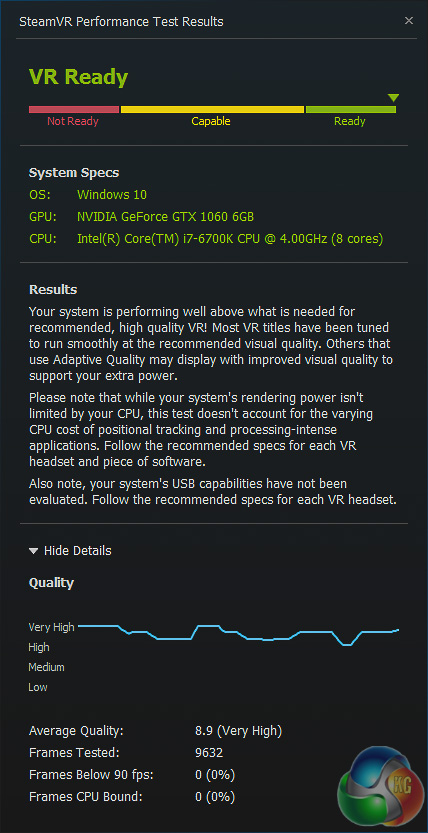
3DMark Fire Strike is a showcase DirectX 11 benchmark designed for today's high-performance gaming PCs. It is our most ambitious and technical benchmark ever, featuring real-time graphics rendered with detail and complexity far beyond what is found in other benchmarks and games today.
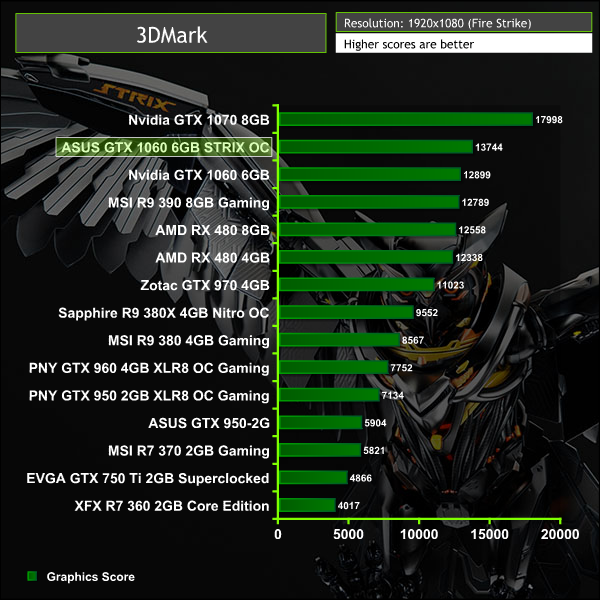
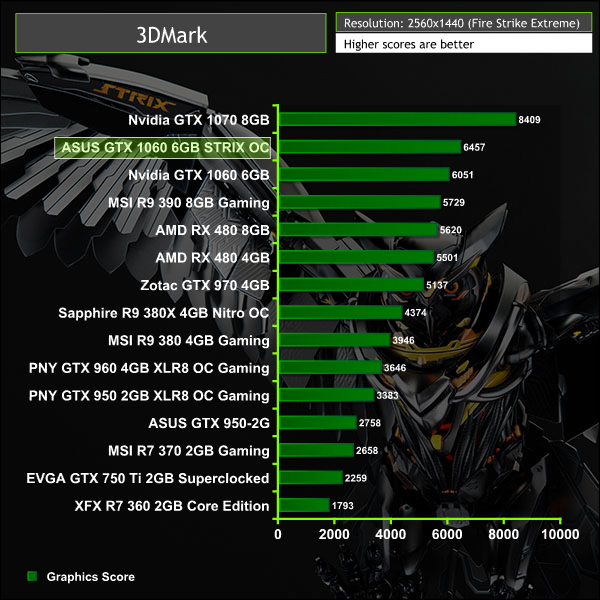
3DMark demonstrates an incremental improvement for the STRIX OC over the Founders Edition.
UNIGINE Valley Benchmark is a new GPU stress-testing tool from the developers of the very popular and highly acclaimed Heaven Benchmark. The forest-covered valley surrounded by vast mountains amazes with its scale from a bird’s-eye view and is extremely detailed down to every leaf and flower petal.
This non-synthetic benchmark powered by the state-of-the art UNIGINE Engine showcases a comprehensive set of cutting-edge graphics technologies with a dynamic environment and fully interactive modes available to the end user.
We test Unigine Valley using the Extreme HD Preset, changing the resolution setting only for 1440p.

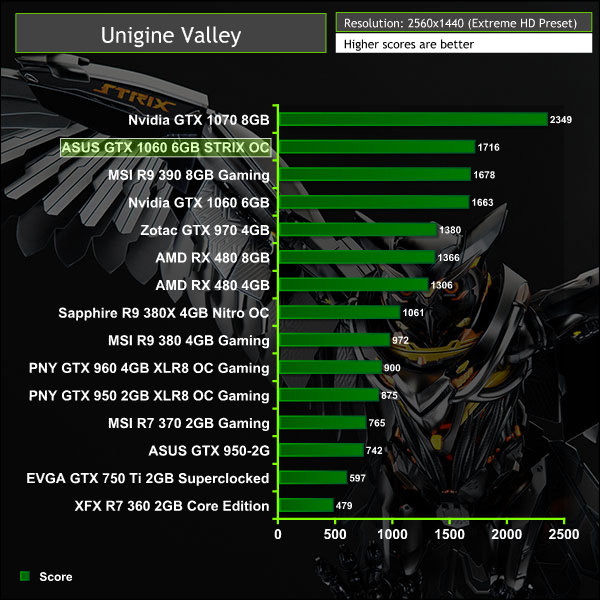
With a little bit more power under the hood than the Founders Edition, the ASUS GTX 1060 STRIX OC leaps into second place in our 1440p Unigine Valley test.
Ashes of the Singularity is a real-time strategy game set in the future where descendants of humans (called Post- Humans) and a powerful artificial intelligence (called the Substrate) fight a war for control of a resource known as Turinium.
Players will engage in massive-scale land/air battles by commanding entire armies of their own design. Each game takes place on one area of a planet, with each player starting with a home base (known as a Nexus) and a single construction unit.
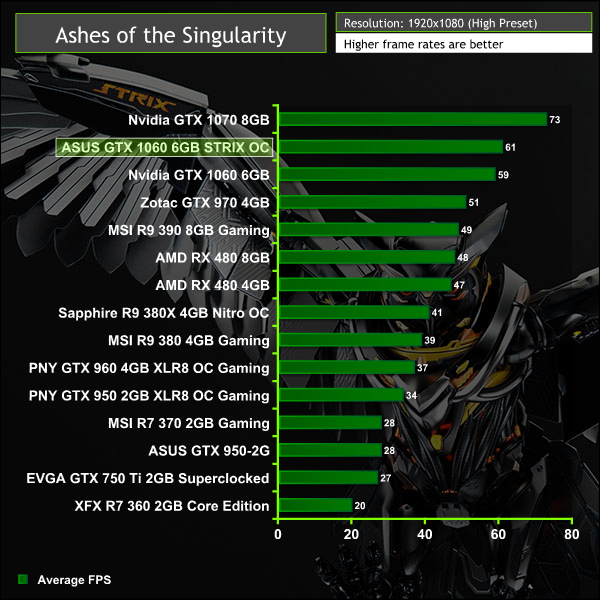
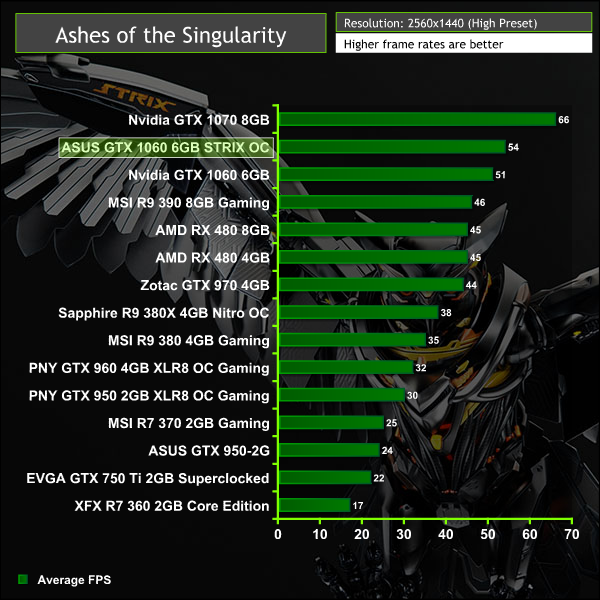
The ASUS STRIX OC GTX 1060 is clocked 8% higher on the core and 3% higher on the memory but this doesn't always translate into an equivalent amount of performance gain over the Founders Edition.
Grand Theft Auto V is an action-adventure game played from either a first-person or third-person view. Players complete missions—linear scenarios with set objectives—to progress through the story. Outside of missions, players may freely roam the open world. Composed of the San Andreas open countryside area and the fictional city of Los Santos, the world is much larger in area than earlier entries in the series. It may be fully explored after the game’s beginning without restriction, although story progress unlocks more gameplay content.
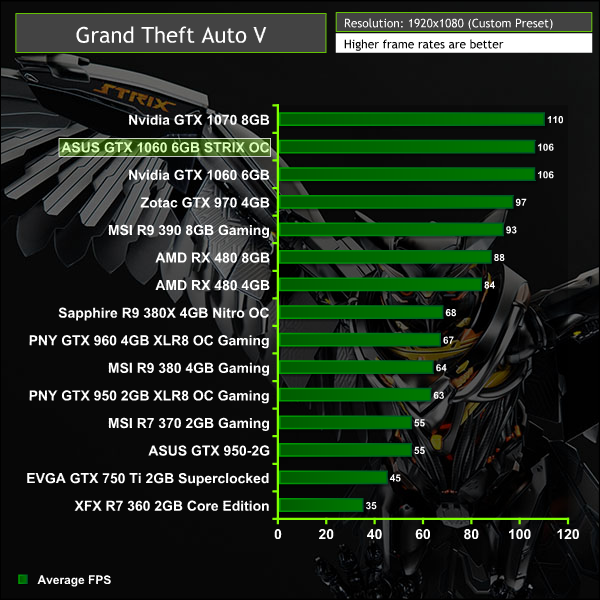
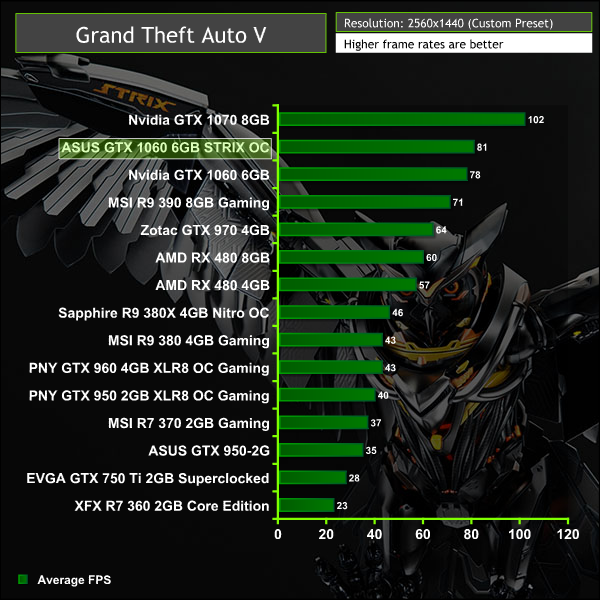
GTA V seems to be CPU-bound at 1080p so it's only at 1440p that the ASUS STRIX 1060 stretches its legs a bit over the reference design.
Just like the original game Metro 2033, Metro: Last Light is played from the perspective of Artyom, the player-character. The story takes place in post-apocalyptic Moscow, mostly inside the metro system, but occasionally missions bring the player above ground. Metro: Last Light takes place one year after the events of Metro 2033, following the canonical ending in which Artyom chose to proceed with the missile strike against the Dark Ones (this happens regardless of your actions in the first game). Redux adds all the DLC and graphical improvements.
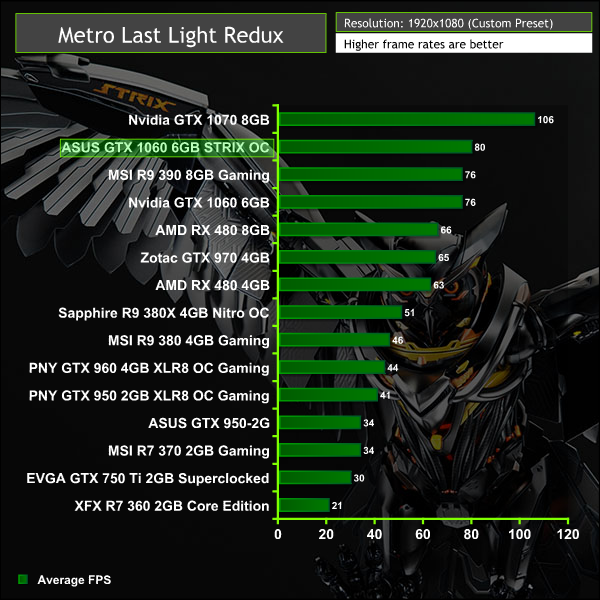
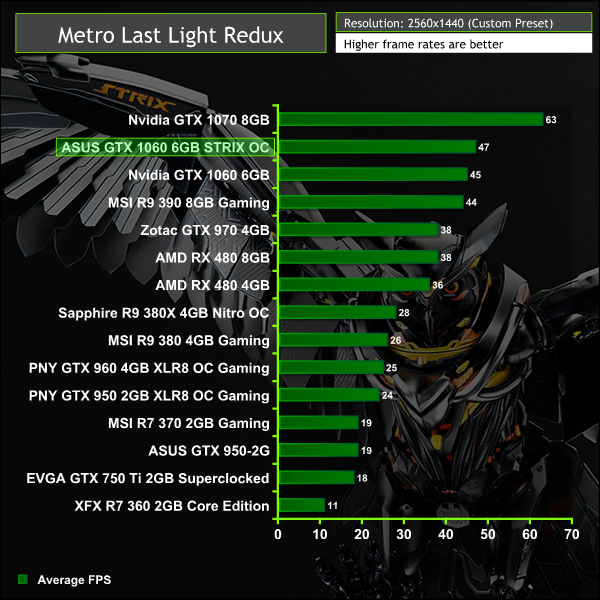
Another couple of frames per second for the ASUS STRIX OC GTX 1060 sees it the second fastest GPU on test in Metro Last Light.
Middle-earth: Shadow of Mordor is a third-person open world video game, where the player controls a ranger by the name of Talion who seeks revenge on the forces of Sauron after his family, including his wife, are killed. Players can travel across locations in the game through parkour, riding monsters, or accessing Forge Towers, which serve as fast travel points.
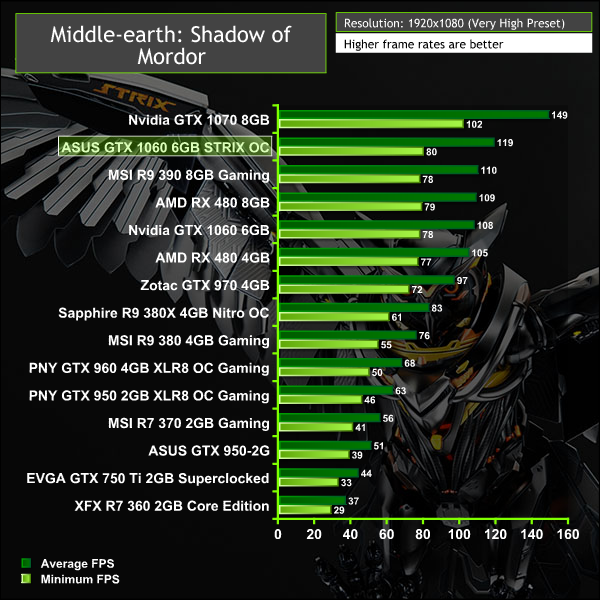
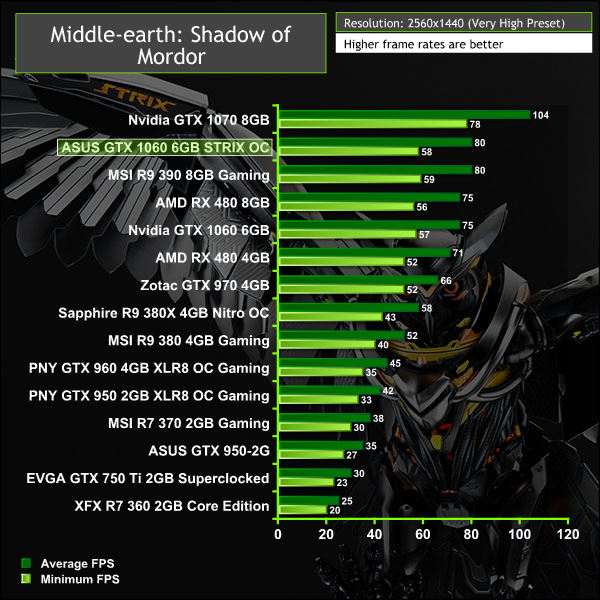
The extra frequency helps the ASUS GTX 1060 edge out the RX 480 in Middle-Earth, though an overclocked RX 480 would likely leap-frog back into the lead.
Rise of the Tomb Raider is a third-person action-adventure game that features similar gameplay found in 2013’s Tomb Raider. Players control Lara Croft through various environments, battling enemies, and completing puzzle platforming sections, while using improvised weapons and gadgets in order to progress through the story. It uses a Direct X 12 capable engine.
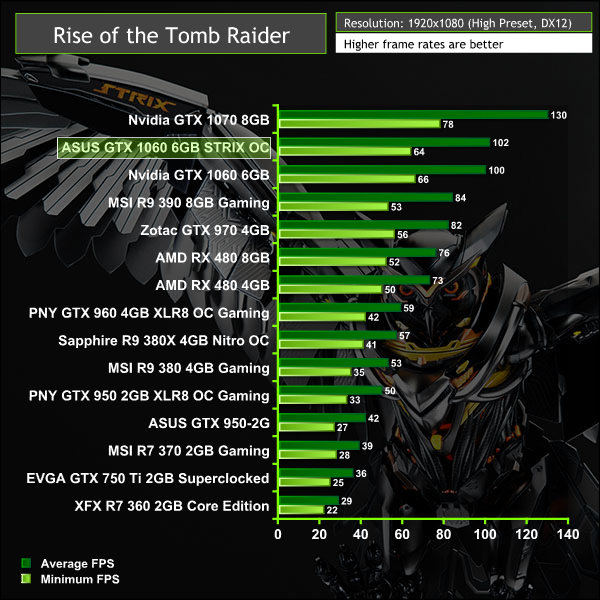
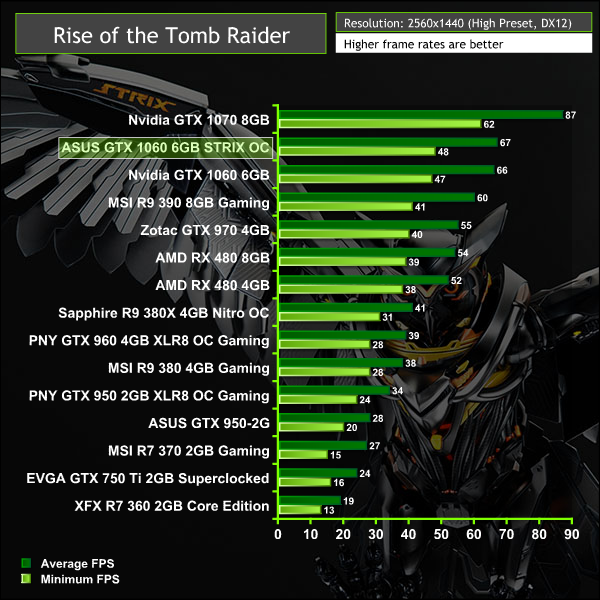
Rise of the Tomb Raider in DX12 mode delivered only a very small increase in performance with the ASUS card, it's almost margin of error.
Our acoustic measurements are less precise on this mid-range test system, the noise floor of the totally quiet testing room is 35 dBA as measured with a Benetech GM1351 Digital Sound Level Meter.
We take our measurements with the decibel meter protruding off the front-top section of the chassis, overhanging by exactly 1 inch. The underlying noise level of the system, generated by the 800 RPM Noctua case fans and H100i with fixed 700RPM fans is 39 dBA, thus anything above this level can be attributed to the graphics card since the PSU is passive for most of it's power capability.
Noise levels were measured after 10 minutes of load under three scenarios: Furmark GPU stress test, Unigine Valley looping at the Extreme HD preset and desktop idle.
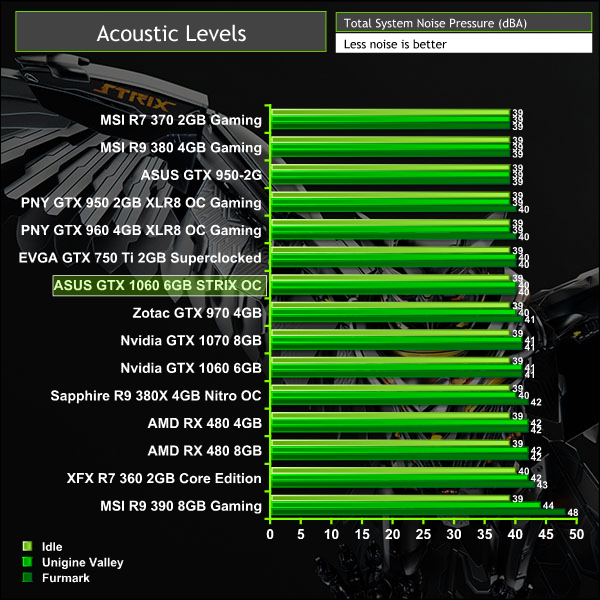
The peak fan speed under furmark of 1700 RPM (47 %) is very quiet, barely noticeable above the background noise level from the PSU, CPU cooler and case fans. However, ASUS could perhaps be a little more reserved with the fan profile given how low the temperatures are.
At idle this graphics card does turn the fans off as part of a passive mode.
Temperatures were measured after 10 minutes of load under three scenarios: Furmark GPU stress test, Unigine Valley looping at the Extreme HD preset and desktop idle. GPU-Z was used to record the maximum temperature, fan profiles were left to their default behaviour.
Delta temperatures are presented below to account for small fluctuations in room temperature, but for all the testing present in this graph the temperature ranged from 21.4 to 23.5 degrees Celsius.
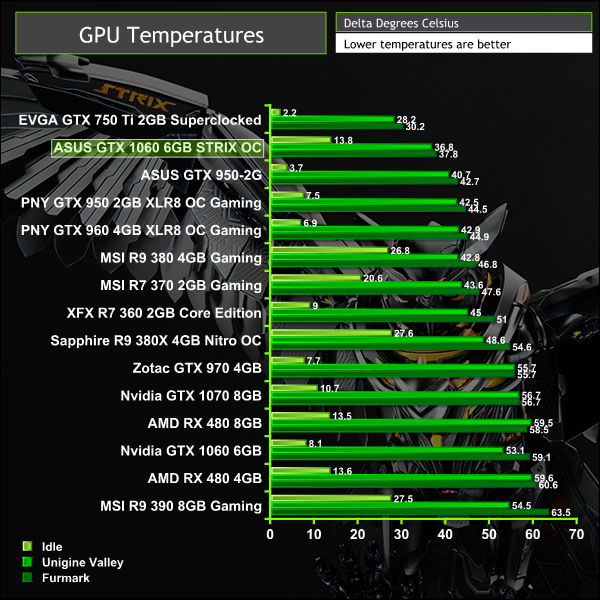
Temperatures are absolutely stellar, in the high 50s for a standard room temperature environment. The cooling solution is over-engineered for this GPU, but that's certainly nothing to complain about.
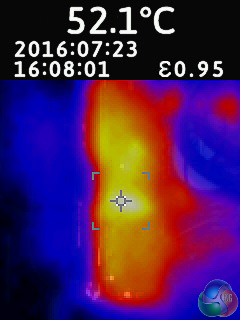
The hottest part of the card was in the low 50s which is a very safe temperature given this card was going through a Furmark torture test.
Power consumption was measured after 10 minutes of load under three scenarios: Furmark GPU stress test, Unigine Valley looping at the Extreme HD preset and desktop idle. The measurement was taking using an Energenie ENER007 power meter and measured for the whole system, excluding the monitor.
While Furmark and desktop idle provide stable and consistent power read-outs, Unigine Valley does not so the power reading is taken as the highest value in Scene 1 of 18.
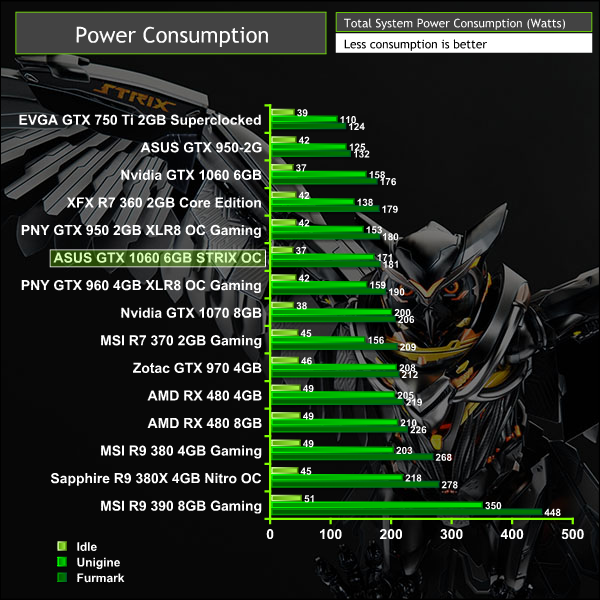
Power consumption does increase over the Founders Edition, as you'd expect given the higher clock speeds. There's about 10-20 watts more power consumption meaning the ASUS GTX 1060 STRIX is still more power efficient than all of AMD's offerings in the same performance segment.
Overclocking results were standard-fare for a GTX 1060 and only a few MHz higher than what we achieved on the Founders Edition. Certainly there's no speed binning or cherry picking going on with this SKU which more firmly cements the conclusion that there's no need to buy the more expensive STRIX OC variant when you can easily overclock the standard STRIX to the same levels.
Any variance between the two would be down to random silicon variation. The effective peak clock speed is just shy of 2.1GHz, a highly impressive number.
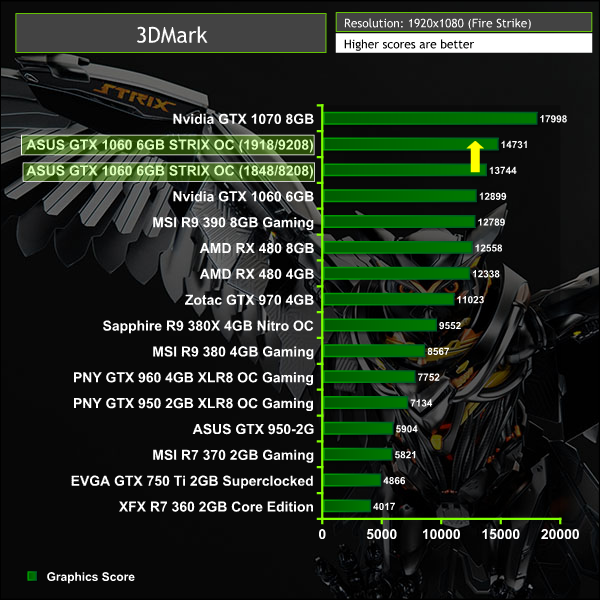
The ASUS averaged 14731 points in 3DMark compared to 14290 for the Founders Edition in its overclocked state. The combination of the extra few MHz and absence of thermal throttling explains that difference.
Both GTX 1080 Strix and GTX 1070 Strix were excellent products and received KitGuru's top Must Have award, in many ways the STRIX GTX 1060 is a predictable conclusion since it uses the same cooling solution and overall design philosophy.
ASUS offers the GTX 1060 STRIX OC at £320/$330 and the GTX 1060 STRIX at £300/$310, the latter of which is a fair price given ASUS has other lesser-spec'd GTX 1060 options to cater to lower price points including the GTX 1060 Dual, Dual OC and Turbo. It's also only about 10% more expensive than the Founders Edition, given all the extra features and functionality that's a premium well worth paying.
The ROG STRIX model is about offering the best feature set for the Nvidia GTX 1060 GPU and this card does that. It's built like a tank with a cooling solution that is engineered to handle a GTX 1080, meaning the GTX 1060 is cooled without breaking a sweat.
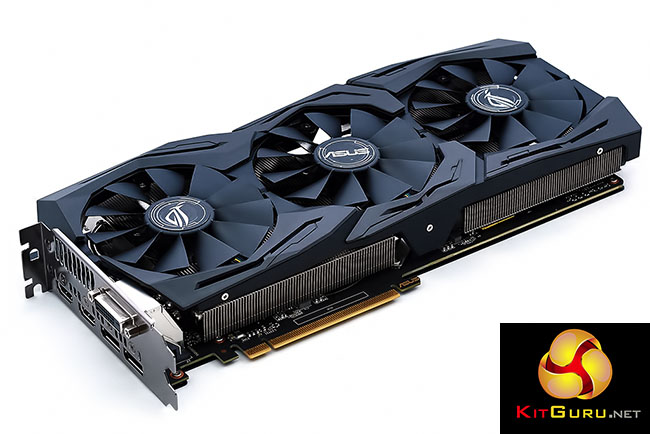
There are a number of other extra features that add value and justify the price point beyond the excellent cooler. The onboard fan headers are actually a smart idea since, generally speaking, the GPU will be the single biggest heat source in a system so having the GPU temperature dictate the case fan behaviour makes sense. The RGB lighting and backplate help to give a premium finish to the card that other cheaper GTX 1060s lack.
There is an inherent danger though, at least with the OC model, that pricing is falling too close to the GTX 1070s. In the UK these GTX 1070s start from £370 while ASUS expects £320 for the STRIX OC GTX 1060. Arguably the OC model fails to be relevant since the standard clocked model can be overclocked to the same level in seconds, saving customers money and effectively delivering the exact same product.
Our testing also demonstrated that the OC model doesn't bring with it any additional overclocking headroom either.

Buy from Overclockers UK for £325.99 inc vat HERE.
Discuss on our Facebook page, over HERE.
Pros
- Astounding cooling performance
- Quiet operation
- RGB functionality
- Backplate
- Passive fan mode at low loads
- 2 x HDMI ports for VR
Cons:
- OC model is too expensive
- Larger than it needs to be for the TDP
KitGuru says: An over-engineered cooling solution and plentiful range of features, the ASUS GTX 1060 STRIX is an excellent upgrade over the Founders Edition.

 KitGuru KitGuru.net – Tech News | Hardware News | Hardware Reviews | IOS | Mobile | Gaming | Graphics Cards
KitGuru KitGuru.net – Tech News | Hardware News | Hardware Reviews | IOS | Mobile | Gaming | Graphics Cards

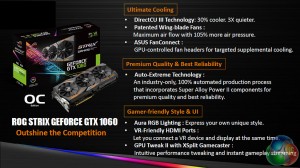
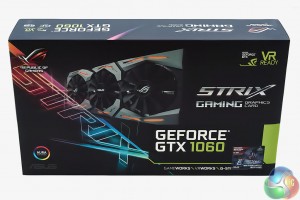
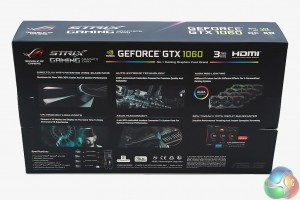
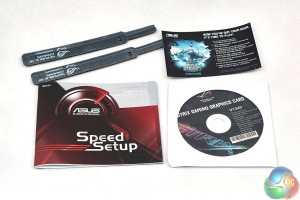
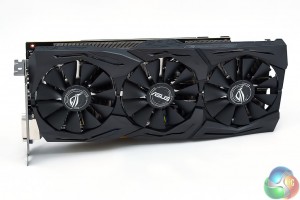
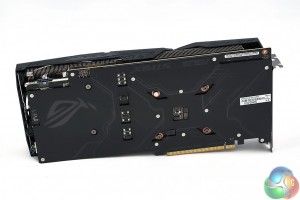
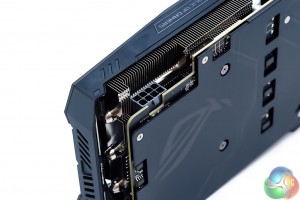
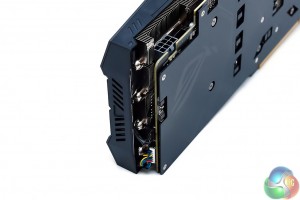
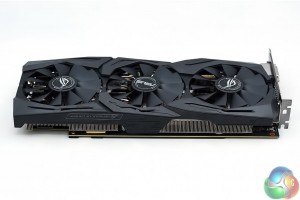
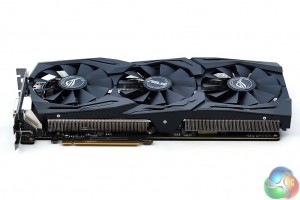
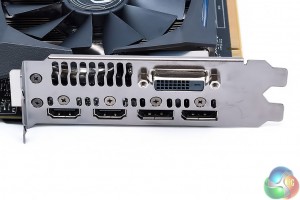
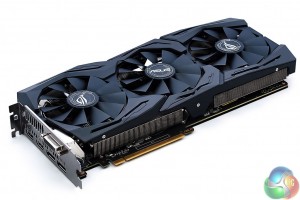
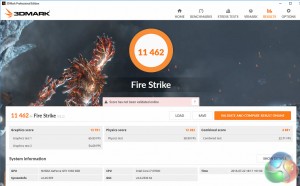

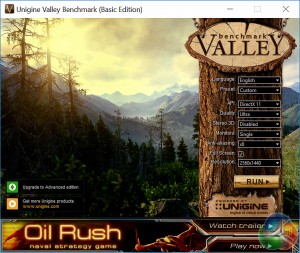

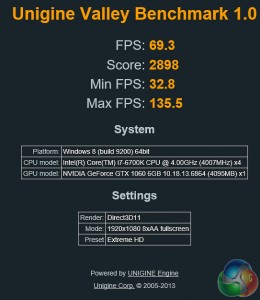
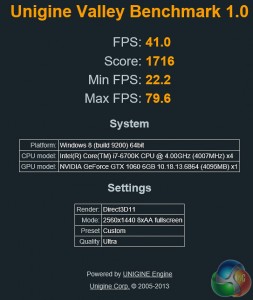
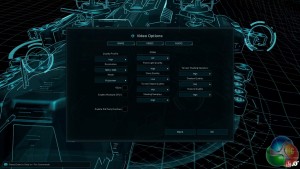


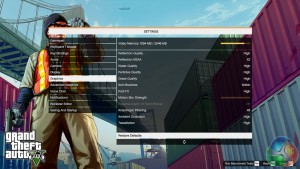

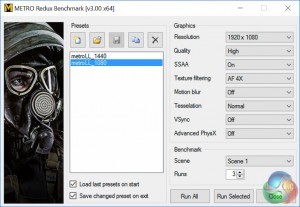


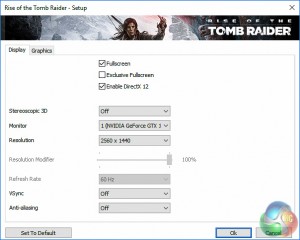
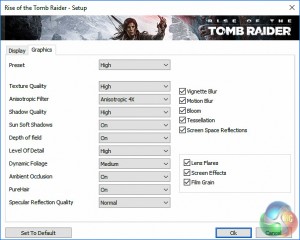
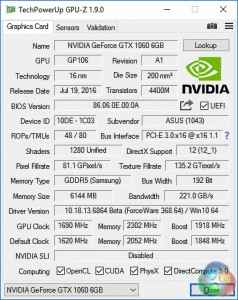
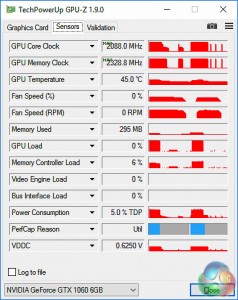
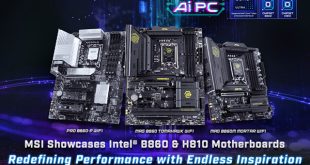
I currently make approximately $6.000-$8.000 on monthly basis doing an online job. Those who are ready to work easy at home work for few h /day from your couch at home and make solid paycheck in the same time… This is a work for you… SELF15.COM
Why isn’t there a GTX 980 in this lineup, seeing as it’s supposedly the 1060’s most comparable card? would have been interesting to see the differences between the two.
performance wise, a stock 1060 is like an overclocked 970
Hi N3XUS. While that may be true. Isn’t a heavily overclocked 970 comparable to a stock 980? I’ve heard elsewhere that the 1060 is around the 980 performance wise. Wondered why there wasn’t one included in the lineup. I would have been interested to see where the 1060 lay in between the two (970 and 980).
The card is phenomenal…. Only problem is the price here in Canada… retailers that have this particular model are charging upwards of $459 to $469… Not enough of a performance boost to replace a RX480 ($309 – $329 Canadian) and to close to a GTX 1070 price wise… (I would just step up to 1070 instead of getting this unit).
Hey! Yes, you’re right a 970 with a nice OC can indeed reach 980 levels of performance.
You should check out this vid if you’re still curious: https://www.youtube.com/watch?v=3W7WX6pjL-M
Why on the first screenshot on GTA V, there is 2048 video memory?
this one, or Gigabyte G1 gaming gtx 1060?
same base and boost clock
I’m sure I answered this question before, maybe it was someone else. Anyway the screenshots are there just to provide the settings we use for benchmarking each game. When these settings screenshots were taken it was a GTX 750 Ti, which has 2GB.
6-8 bucks? That’s not much mate. Learn to use a comma instead of a decimal point ya scamming cunt